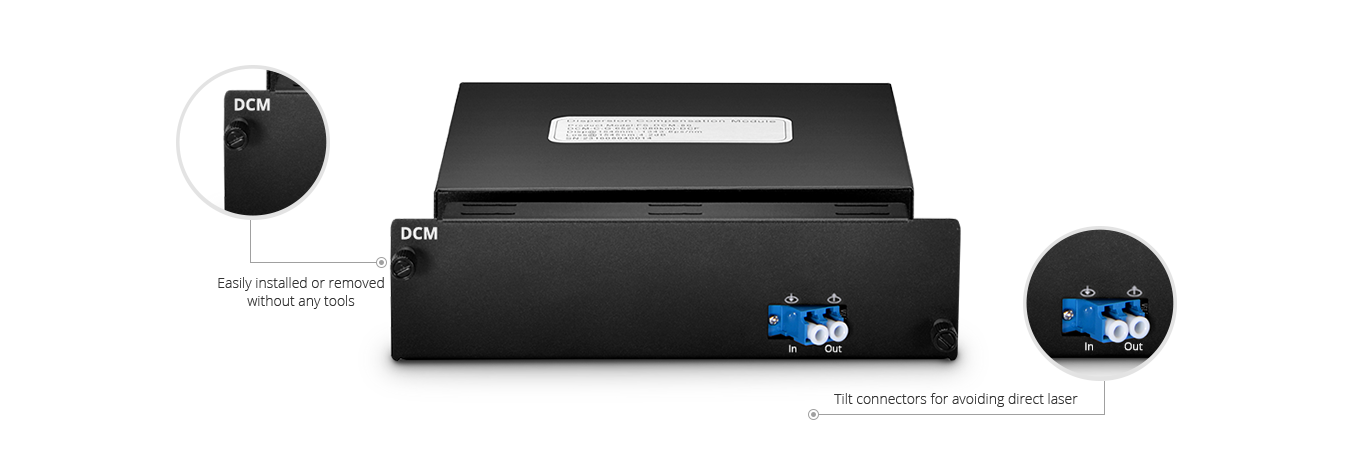Dispersion Compensation Module for Long-Haul DWDM System
In recent years, DWDM (dense wavelength division multiplexing) technology has made tremendous progress on transmission capacity, which is defined by optical signal modulation method and transmission bandwidth. As the transmission bandwidth is fixed, allowable dispersion values are in inverse proportion to the square of transmission speed. Therefore, the faster the transmission speed, the more important the compensation of accumulated chromatic dispersion over transmission bandwidth. This paper will introduce two kinds of dispersion and illustrate dispersion compensation module solutions for long-haul DWDM systems.
Dispersion in DWDM Optical Transmission System
Before learning about dispersion compensation modules, we’d first illustrate dispersion types in optical transmission systems. Dispersion is referred to as the broadening of light pulses and is a consequence of the physical properties of the transmission medium. When optical signals are transmitted over optical links, different wavelength components of the optical signals will generally experience different propagation times due to the fact that an optical fiber has different effective refractive indices for different wavelengths, which results in a pulse distortion and broadening. This phenomenon is referred to as dispersion. Dispersion reduces the effective bandwidth and escalates the error rate due to an increasing intersymbol interference, which has become a critical factor limiting the quality of signal transmission over optical links. There are mainly two kinds of dispersion in fiber optical transmission, Polarization Mode Dispersion (PMD) and Chromatic Dispersion (CD).
Chromatic Dispersion Basis
Polarization Mode Dispersion (PMD) is a form of dispersion where optical pulses are spread because optical signals in different phase status are transmitted at different speeds due to the random birefringence of optical fibers. While Chromatic Dispersion (CD) is a form of dispersion where optical pulses are spread because different wavelengths are transmitted at different speeds in optical fibers and the periods for different wavelengths to traverse the same distance are different. Chromatic dispersion is the most significant impairment that should be considered in fiber transmission systems. There are two physical issues accounting for the chromatic dispersion in optical fibers: material dispersion and waveguide dispersion.
Material Dispersion – Material dispersion occurs due to the fact that the core and cladding of fibers are made of dispersive materials and this means that the refractive index is frequency dependent. Material dispersion is the principle component of chromatic dispersion for most fibers.
Waveguide Dispersion – Waveguide dispersion is caused due to physical structure of the waveguide and is wavelength dependent. The larger the wavelength, the more the fundamental mode will spread from the core into the cladding. Waveguide dispersion is important in waveguides with small effective mode areas such as optical single-mode fibers.
DCM - Solutions for Chromatic Dispersion Compensation
Nowadays, there are various methods allowing for dispersion compensation in fiber optics, such as dispersion compensation module (DCM), dispersion compensation fiber (DCF), typical bragg grating operation, chirped fiber bragg grating, etc. For fiber optical high bit rate (such as 10G or 40G bit/s) long-haul transmission systems, dispersion compensation module is one of the most important items to be considered for chromatic dispersion compensation. The dispersion compensating module compensates the cumulative dispersion in a single mode fiber and a dispersion coefficient is used to characterize the dispersion value. The value for regular single mode fiber is around +16~17 ps/(nm*km) at 1550 nm. To properly manage this, the DCM is built by using a special type of dispersion compensating fiber inside the module that has a negative value of dispersion coefficient, ranging from -30 to -300 ps/(nm*km). The DCM can be used to compensate for chromatic dispersion from 10 Mbps to 40 Gbps data rates in ultra long haul coherent networks, such as SDH/SONET, CATV and DWDM systems. These modules can achieve -10 to -2100 ps/nm of dispersion values at 1550 nm wavelength and offer a high-level compensation for standard single mode fiber (SMF28 – G.652 fiber) across entire C-Band while maintaining an extremely low and flat insertion loss as well as low latency. When combined with EDFA and OEO, DCM provides a simple, reliable, and cost-effective long-haul transport solution, making signals go further without regeneration.

Figure 1: DCF-Based Passive Dispersion Compensation Module
Dispersion Compensation Module Use Case Study
As an example, the cumulative dispersion for a 10km length of fiber will be +160~170 ps/nm, so in order to compensate for that amount of dispersion, a DCM module will be added to the link with a specific and calculated fiber length aimed at reducing the total dispersion close to 0 ps/(nm*km).
As seen below, the signal begins to disperse as soon as it leaves the source, which means it can not be recognized at the receiver side. But with a DCM module, the lost signals can be compensated before the receiver can effectively neutralize the fiber’s dispersion, which eventually guarantees normal working and ensures reliable long-haul transmission.

Figure 2: Use Case of Dispersion Compensation Module
Typically, a DCM module provides a fixed amount of dispersion (e.g. normal dispersion in the 1.6-μm spectral region), although tunable dispersion modules are also available. A module can easily be inserted into a fiber-optic link because it has fiber connectors for the input and output. The insertion losses may be compensated with a fiber amplifier (e.g. an EDFA in a 1.5-μm telecom system). A dispersion compensation module is often placed between two fiber amplifiers in a long-haul DWDM system.
You might be interested in
Email Address

-
PoE vs PoE+ vs PoE++ Switch: How to Choose?
Mar 16, 2023














